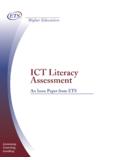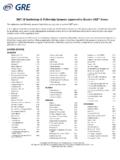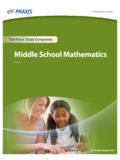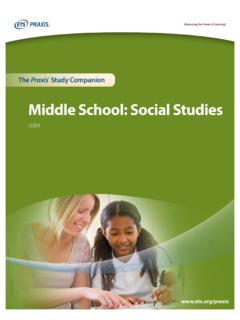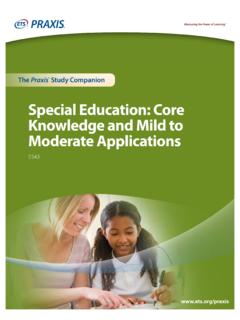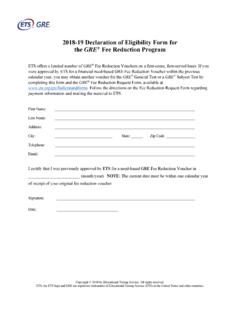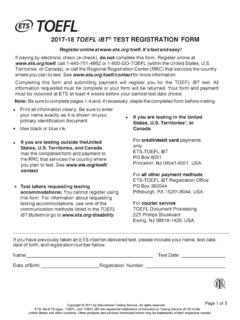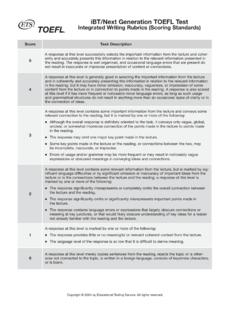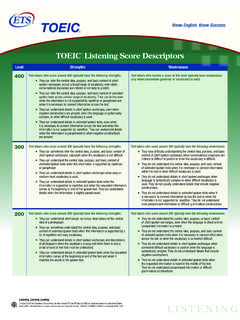Transcription of Teacher Classroom Practices and Student Performance: How ...
1 RESEARCHREPORTS eptember 2001RR-01-19 Statistics & Research DivisionPrinceton, NJ 08541 Teacher Classroom Practicesand Student Performance: HowSchools Can Make a DifferenceHarold WenglinskyTeacher Classroom Practices and Student Performance: How Schools Can Make a DifferenceHarold WenglinskyEducational Testing ServiceSeptember 2001 Research Reports provide preliminary and limited dissemination ofETS research prior to publication. They are available withoutcharge from:Research Publications OfficeMail Stop 10-REducational Testing ServicePrinceton, NJ 08541iAbstractQuantitative studies of school effects have generally supported the notion that the problems education lie outside of the school. Yet such studies neglect the primary venue throughwhich students learn, the Classroom . The current study explores the link between classroompractices and Student academic performance by applying multilevel modeling to the 1996 National Assessment of Educational Progress in mathematics.
2 The study finds that the effects ofclassroom Practices , when added to those of other Teacher characteristics, are comparable in sizeto those of Student background, suggesting that teachers can contribute as much to studentlearning as the students words: instructional Practices , NAEP, mathematics, Teacher qualityiiAcknowledgementsThe author thanks the Milken Family Foundation which, through its generous financial support,made the research upon which this article is based possible. The author also thanks Paul Barton,Daniel Eignor, Claudia Gentile, Drew Gitomer, Robin Henke, Nancy Knapp, John Mazzeo, andLewis Solmon for their helpful input at various stages of the project. An earlier version of thispaper was presented at the Annual Meeting of the American Educational Research Associationin Seattle, Washington, in April 2001. The views expressed are solely those of the of the discussion in educational reform hinges on the question of whether schoolsmatter. Over the past two decades, policymakers have called for improvements in the academicperformance of students .
3 Many educational reformers, particularly those associated with thestandards movement, hold that the key to improving Student performance lies in improvingschools. If academic standards are rigorous, curriculum and assessments are aligned to thosestandards, and teachers possess the skills to teach at the level the standards demand, studentperformance will improve. However, this perspective is to some extent at odds with another thathas emerged from the discussion about school improvement, namely that it is students ratherthan schools that make the difference. Hence a New York Times story on how to improve theacademic performance of low-income students can include the headline: What No School CanDo (Traub, 2000). Or, as Laurence Steinberg puts it in Beyond the Classroom : Why SchoolReform has Failed and What Parents Need to Do, neither the source of our achievementproblem, nor the mechanism through which we can best address it, is to be found by examiningor altering schools (Steinberg, 1996, p.)
4 60). In this view, it is the social backgrounds of studentsthat play the key role in their ability to learn, and only by moving outside of the educationalsystem and attacking the pervasive economic inequalities that exist in the United States canstudent performance be research on whether schools matter has generally supported the notion thatthe problems of education lie outside of the schools. Some research finds that when thesocial backgrounds of students are taken into account, school characteristics do not seem toinfluence Student outcomes, suggesting that schools do not serve as avenues for upward mobility,but instead reinforce existing social and economic inequalities (Coleman et al., 1966; Jenckset al., 1972). Other researchers contend that school characteristics can have a greater effect onstudent outcomes than would be expected based upon Student background (Lee, Bryk, & Smith,1993). But while the research in support of this contention does find significant effects for schoolcharacteristics, the magnitudes of these effects tend to be modest, far overshadowed by theeffects of Student background possible reason for the lack of large school effects in quantitative research is the failureof such research to capitalize on an insight from qualitative research: the central importance ofthe Classroom Practices of teachers.
5 As far back as Willard Waller (1932), qualitative researchers2have noted that the interaction that occurs between teachers and students in the Classroom isgreater than the sum of its parts. students can leave the Classroom with their knowledge andattitudes dramatically altered from what they were before they entered. Quantitative researchneglects this dimension of schooling by treating it as a black box, not worthy of study (Mehan,1992). Often teaching is not studied at all, and when it is, only the characteristics of teachers thatare easily measured but far removed from the Classroom (such as their level of educationalattainment) are current study seeks to fill this gap in the literature by using quantitative methods tostudy the link between Student academic achievement and Teacher Classroom Practices , as well asother aspects of teaching, such as the professional development teachers receive in support oftheir Classroom Practices and the more traditional Teacher background characteristics, referred tohere as Teacher inputs.
6 Such a study is made possible by the availability of a large-scalenationally representative database, the National Assessment of Educational Progress (NAEP),which includes a comprehensive set of Classroom Practices along with Student test scores andother characteristics of students and teachers. For this study, the 7,146 eighth-graders who tookthe 1996 assessment in mathematics are studied along with their mathematics teachers. Thestatistical technique of multilevel structural equation modeling (MSEM) is employed to addressthe major methodological shortcomings of the quantitative literature, namely the failure todistinguish between school- and Student -level effects, to measure relationships amongindependent variables, and to explicitly model measurement error. The study finds thatclassroom Practices indeed have a marked effect on Student achievement and that, in concertwith the other aspects of teaching under study, this effect is at least as strong as that of studentbackground.
7 This finding documents the fact that schools indeed matter, due to theoverwhelming influence of the Classroom Practices of their of the quantitative literature linking school characteristics to Student outcomesfocuses on the impact of economic characteristics, or school resources. These studies are knownas production functions. One of the earliest of these studies was the Equality of EducationalOpportunity Study, commonly referred to as the Coleman Report (Coleman et al., 1966). This3study applied ordinary least squares (OLS) regression analysis to nationally representativesamples of elementary and secondary school students to relate school resources such as per-pupilexpenditures to Student academic achievement and other outcomes. The study found that, onaverage, when Student background was taken into account, school resources were notsignificantly associated with Student outcomes. Nearly 400 additional production functionstudies have since been conducted. Meta-analyses tabulating the results of such studies between1964 and 1994 reached divergent conclusions.
8 Some concluded that these studies showed noconsistent relationship between school resources and Student achievement (Hanushek, 1989,1996a, 1996b, 1997), while others concluded that the studies showed a consistent, albeit modest,positive relationship (Greenwald, Hedges, & Laine, 1996; Hedges & Greenwald, 1996; Hedges,Laine, & Greenwald, 1994).2 Another line of inquiry into the impact of schooling on students , focusing on the socialand organizational characteristics of schools, also emerged from the Coleman Report. This bodyof research, known as effective schools research, sought to identify common characteristics ofschools in which students performed above what would be expected based upon theirbackgrounds (Austin & Garber, 1985; Brookover, Beady, Flood, Schweitzer, & Wisenbaker,1979; Edmonds, 1979). While the earliest of these studies tended to be small in scope, laterstudies using large-scale databases confirmed many of their basic findings (Chubb & Moe, 1990;Lee et al.)
9 , 1993). These studies found that certain characteristics of schools, such as theleadership qualities of the principal, the disciplinary environment of the school, and the size ofthe Student body, all had an effect on Student outcomes. In comparison to Student background,however, these effects appeared quite of the quantitative research that focused specifically on teaching conformed to asimilar pattern, finding little relationship between Teacher inputs and Student achievement. TheColeman Report measured seven Teacher characteristics: years of experience, educationalattainment, scores on a vocabulary test, ethnicity, parents educational attainment, whether theteacher grew up in the area in which he or she was teaching, and the Teacher s attitude towardteaching middle-class students . For most students , this study found these characteristics toexplain less than 1% of the variation in Student test scores. The findings of the meta-analyses ofproduction function studies were just as mixed for Teacher inputs as for other school found that less than one-third of the studies could document a link between student4outcomes and Teacher experience, less than one-quarter could do so for Teacher salaries, and just1 in 10 could do so for educational attainment; from such mixed results, the meta-analyses cameto divergent conclusions, some suggesting a positive relationship and some suggesting recent research on teaching has confirmed the lack of a clear relationship betweenstudent outcomes and Teacher inputs, but with two exceptions: the amount of course work theteacher had pursued in the relevant subject area and the Teacher s scores on basic skills analyses of large-scale databases revealed that exposure teachers received to college-levelcourses in the subject they were teaching led to better Student performance.
10 Monk (1994)analyzed 2,829 high school students from the Longitudinal Study of American Youth. Thesestudents were tested in mathematics and science in 10th, 11th, and 12th grades, and filled outquestionnaires on their background characteristics. Their mathematics and science teachers werealso surveyed. The study related Teacher characteristics to Student test scores, taking into accountstudents earlier test scores, background characteristics, and Teacher inputs. The study found thatthe more college-level mathematics or science courses (or math or science pedagogy courses)teachers had taken, the better their students did on the mathematics and science assessments. Themore traditional Teacher inputs that had been measured in the earlier production function studies,such as Teacher experience or educational attainment, proved unrelated to Student results were obtained in a study by Goldhaber and Brewer (1995). They analyzed data on5,149 10th-graders, 2,245 mathematics teachers, and 638 schools drawn from the NationalEducational Longitudinal Study of 1988 (NELS:88).
